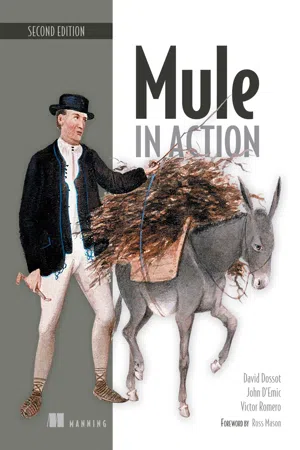
- 432 pages
- English
- ePUB (mobile friendly)
- Available on iOS & Android
Mule in Action
About this book
Summary Mule in Action, Second Edition is a totally-revised guide covering Mule 3 fundamentals and best practices. It starts with a quick ESB overview and then dives into rich examples covering core concepts like sending, receiving, routing, and transforming data. About the Technology An enterprise service bus is a way to integrate enterprise applications using a bus-like infrastructure. Mule is the leading open source Java ESB. It borrows from the Hohpe/Woolf patterns, is lightweight, can publish REST and SOAP services, integrates well with Spring, is customizable, scales well, and is cloud-ready. About the Book Mule in Action, Second Edition is a totally revised guide covering Mule 3 fundamentals and best practices. It starts with a quick ESB overview and then dives into rich examples covering core concepts like sending, receiving, routing, and transforming data. You'll get a close look at Mule's standard components and how to roll out custom ones. You'll also pick up techniques for testing, performance tuning, and BPM orchestration, and explore cloud API integration for SaaS applications.Written for developers, architects, and IT managers, this book requires familiarity with Java but no previous exposure to Mule or other ESBs.Purchase of the print book includes a free eBook in PDF, Kindle, and ePub formats from Manning Publications. What's Inside
- Full coverage of Mule 3
- Integration with cloud services
- Common transports, routers, and transformers
- Security, routing, orchestration, and transactions
About the Authors David Dossot is a software architect and has created numerous modules and transports for Mule. John D'Emic is a principal solutions architect and Victor Romero a solutions architect, both at MuleSoft, Inc. Table of Contents
PART 1 CORE MULE
- Discovering Mule
- Processing messages with Mule
- Working with connectors
- Transforming data with Mule
- Routing data with Mule
- Working with components and patterns
- PART 2 RUNNING MULE
- Integration architecture with Mule
- Deploying Mule
- Exception handling and transaction management with Mule
- Securing Mule
- Tuning Mule
- PART 3 TRAVELING FURTHER WITH MULE
- Developing with Mule
- Writing custom cloud connectors and processors
- Augmenting Mule with orthogonal technologies
Frequently asked questions
- Essential is ideal for learners and professionals who enjoy exploring a wide range of subjects. Access the Essential Library with 800,000+ trusted titles and best-sellers across business, personal growth, and the humanities. Includes unlimited reading time and Standard Read Aloud voice.
- Complete: Perfect for advanced learners and researchers needing full, unrestricted access. Unlock 1.4M+ books across hundreds of subjects, including academic and specialized titles. The Complete Plan also includes advanced features like Premium Read Aloud and Research Assistant.
Please note we cannot support devices running on iOS 13 and Android 7 or earlier. Learn more about using the app.
Information
Part 1. Core Mule
Chapter 1. Discovering Mule
- An introduction to enterprise integration
- Building, testing, and deploying your first Mule application
- Protocol— Applications can accept input from a variety of means, ranging from a local filesystem to a RESTful API.
- Data format— Speaking the right protocol is only part of the solution, since applications can use almost any form of representation for the data they exchange.
- Invocation styles— Synchronous, asynchronous, RPC, messaging, and batch call semantics entail very different integration strategies.
- Lifecycle and management— Applications of different origins that serve varied purposes tend to have disparate development, maintenance, and operational lifecycles.
- Error handling— Error handling is crucial in any application and is amplified with applications that are forced to integrate with remote, and often unreliable, systems.
- Monitoring— Integration applications often have more esoteric monitoring requirements than a traditional web or server-side application. These include the monitoring of transactions per second, awareness of the latency of remote servers, and the absence of events, to name a few.
1.1. Enterprise Integration Patterns and service-oriented architecture
Table of contents
- Copyright
- Brief Table of Contents
- Table of Contents
- Foreword
- Preface
- Acknowledgments
- About this Book
- About the Authors
- About the Cover Illustration
- Part 1. Core Mule
- Part 2. Running Mule
- Part 3. Traveling further with Mule
- Index
- List of Figures
- List of Tables
- List of Listings